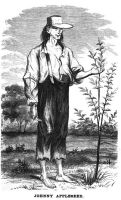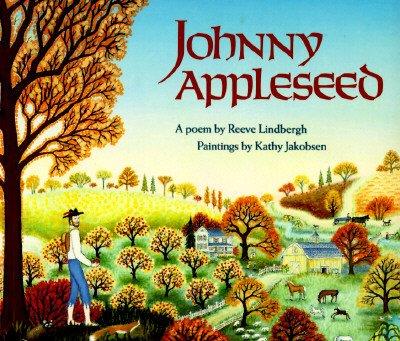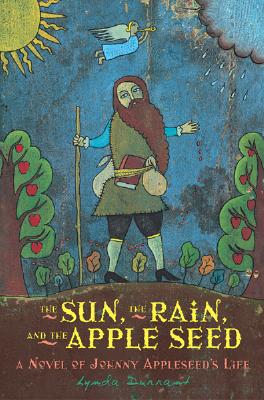Johnny Appleseed, American hermit
The historical John Chapman (1774-1845) became the folkloric Johnny Appleseed even within his lifetime because he exhibited all of the characteristics of what mid-19th century American culture had identified in its frontier herores: eccentric, colorful, but innocuous. Even in Chapman's sixties, contemporary sources were describing him as "ragged," "harmless and lonely," grumpy even as a younger man. He was deemed "almost independent of corporeal wants and sufferings," as "having no family and inured to hardships of every kind."
In short, John Chapman was a classic American hermit. He is part wilderness hermit in his habits, appearance, and livelihood, part religious hermit in his affectations for Swedenborgianism, the beliefs of Emmanuel Swedenborg and the New Church of Jerusalem founded on his writings. Chapman's most recent biographer Howard Means calls Chapman a "New World Saint Francis," somewhere between a Sufi mystic and Henry David Thoreau, and indirectly influenced by the Greek Cynics.
How John Chapman became Johnny Appleseed is a prime example of myth-making. He was born in Massachusetts; his mother died when he was young; his father remarried and filled the new household with step-siblings to John, who departed (with a younger brother in tow) as soon as he was of age. They walked through New York State and into Pennsylvania, finding makeshift work there. John pursued the opportunity to work in a nursery cultivating apple trees, much in demand among western-bound settlers. He also discovered Swedenborgianism, a mystical Christianity recently imported and strongest in Pennsylvania.
Chapman hit upon the notion of procuring apple seeds (abundant in cider mills) to grow trees in clusters on diverse properties he identified for leasing. He was to eventually buy disparate tracts of land in Ohio and Indiana, accommodating the markets of increased westward populations. Chapman's insight concerning apple seed contradicts modern science and marketing, wherein distinct apple trees are grafted in order to produce a predictable variety. But apples in this era, regardless of variety or quality, were used by rough-neck frontiersmen of the era for making cider and vinegar, not for eating or juicing. Tapping this need was a novelty, so that Chapman was quickly dubbed by contemporaries "Johnny Appleseed."
From Pennsylvania, Chapman visited the new settlements of Ohio in the first decades of the 1800s, shrewdly purchasing lots of several acres to grow trees. By the second and third decades, Chapman actively walked the circuit of Ohio's western border with Indiana. Evidence shows that Chapman traversed all of Indiana by the 1830s, anticipating population influx. But no evidence shows that Chapman's itinerancy was related to religious evangelism, though the Great Awakening was in full force. Indeed, his Swedenborgianism had early taken its own subjective course, so that even the New Church congregations ignored the eccentric. Chapman's religiosity was typically that of a hermit, unrelated to congregations and doctrines.
Biographer Means cites many extant sources of the era to demonstrate the consistency of Chapman's Appleseed image, some contemporary but most a generation after Chapman, when the region needed its own frontier mythological hero or personality to rival Daniel Boone and Davy Crockett. Here are some typical quotes:
He seemed as much at home
with the red man of the forest as with his own race.
[He was] impatient of the restraints of civilization, so much so,
indeed, that as soon as settlements began to increase he disposed of
his few improvements ... and ... restless and discontented ... he
drifted further westward.
... the oddest character in all our history.
[not just] an artless child of nature [but] a man of much intelligence.
Biographer Means puts the era into the context of the frontier thesis of Frederick Jackson Turner, one aspect of which argues that with each successive migration westward came a reversion to primitive living. This reversion might be reflected in crude social behavior of drinking and fighting ubiquitous among male settlers, but more benignly evident in someone like Chapman's animism, animal sympathy, herbalism, and esteem for Native Americans. But scholar Robert A. Ferguson (Alone in America) sees frontier individualism more negatively, through the observations of Alexis de Toqueville, Ralph Waldo Emerson, and others, as the product of American transcendentalism's idealization of "self" and the loss of domesticity in frontier movement, resulting in a strong need to mythologize, to create heroes, and to ignore the destructive aspects of their actions. Both approaches explain a great deal about the conflict between American respect for and abuse of nature and the peoples they encountered. Johnny Appleseed was the last representative of the culture's chance to reconcile American values.



Above: The first known depiction of Johnny Appleseed (left) is H.S. Knapp's illustration in a book on Ohio history, 1863. The second (center) is an illustration in Harper's Magazine in 1871. The realistic illustration of a striding Johnny Appleseed (right) is by F. M. Davis in the 1950s.
Ultimately, as Means puts it: "Reduced to almost nothing, John Chapman made an aesthetic of nothing, a virtue of his hardships." Chapman ate off the land but was vegetarian, slept on the ground in the open, wore minimal clothing, even in winter, and walked everywhere barefoot. He was both hero and hermit. Descriptions of Chapman are consistent and reasonable portraits of a hermit and wanderer. Details about his itineraries and specific anecdotes began the drift towards Chapman as Appleseed even during his lifetime. By the twentieth century, details of childhood, religious prosyletizing, and wilderness feats embellished the story.
At his death in his seventies, succumbing to the "winter plague," as influenza was then termed, John Chapman left thousands of apple trees in scattered nurseries, within multiple tracts of land not developed or just forgotten by him. A public monument in Dexter, Ohio, still reads: "In memory of John Chapman, famous "Johnny Appleseed," followed by an epitaph:
Without a hope of
recompense,
Without a thought of pride,
John Chapman planted apple trees,
and preached, and lived, and died.

 ¶
¶
BIBLIOGRAPHICAL REFERENCES
The standard source on John Chapman/Johnny Appleseed is now Howard Means: Johnny Appleseed: the Man, the Myth, the American Story. New York: Simon & Schuster, 2011. This work includes a "selected bibliography." Favorite fictional, poetic, and children's versions are (illustrated above) Reeve Lindbergh: Johnny Appleseed, A Poem. Boston: Joy Street Books, 1993 and Lynda Durrant: The Sun, the Rain, and the Apple Seed: a Novel of Johnny Appleseed. Boston: Clarion Books, 2003.
